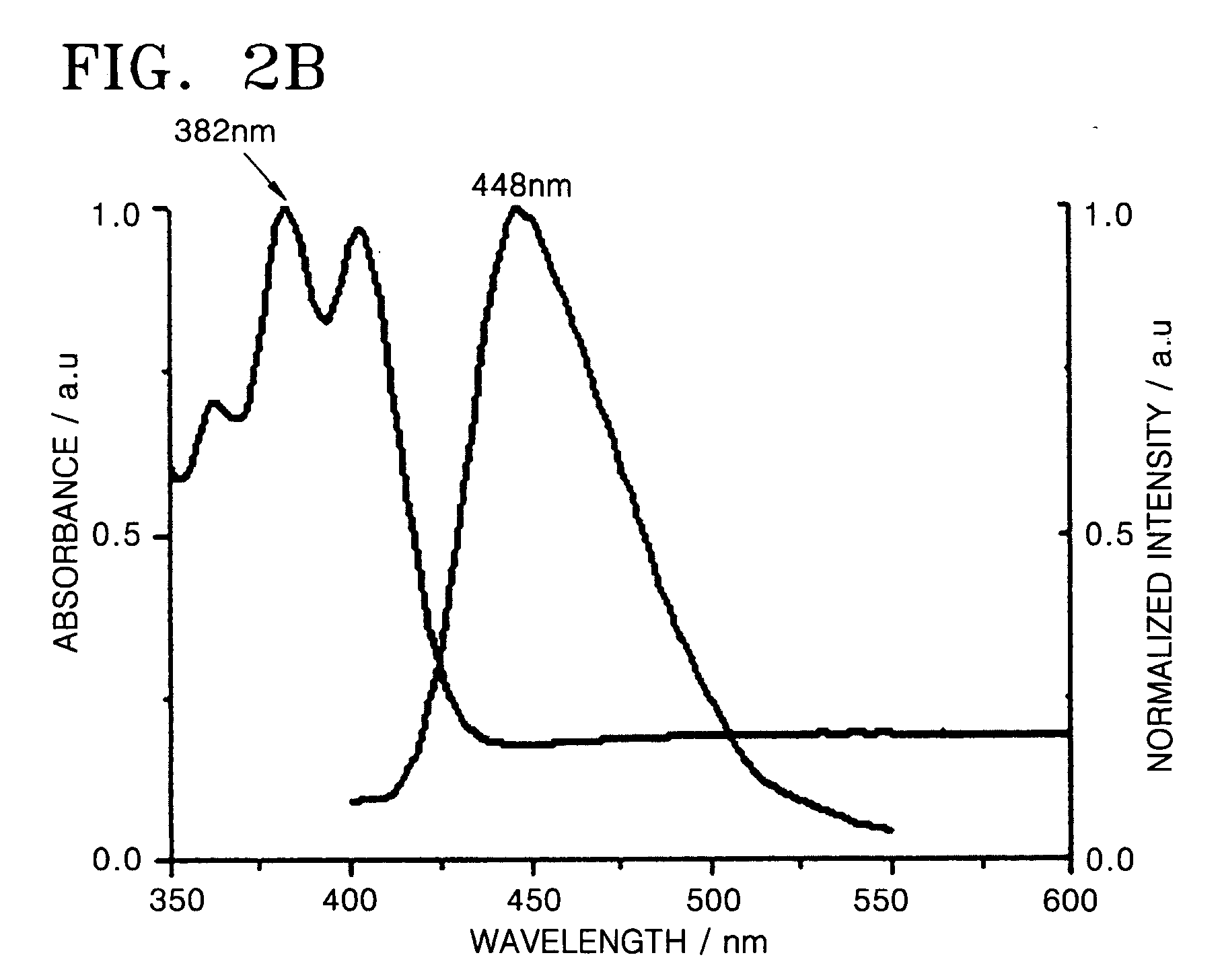Organic light-emitting compound and organic light-emitting device containing the same
a light-emitting compound and organic technology, applied in the direction of discharge tube luminescent screens, organic compounds of the group 5/15 elements, natural mineral layered products, etc., can solve the problems of insufficient resolution of pixels, insufficient thermal stability, color purity, and materials which are compatible with liquid coating, and achieve excellent solubility and thermal stability.
- Summary
- Abstract
- Description
- Claims
- Application Information
AI Technical Summary
Benefits of technology
Problems solved by technology
Method used
Image
Examples
synthesis example 1
Compound 4 represented by Formula 4 was synthesized according to the reaction pathways in Reaction Scheme 1, 2, and 3 below.
Synthesis of Intermediate A
(a) Synthesis of 9-p-tolyl-anthracene
5 g (1 eq, 15.6 mmol) of 9-bromo anthracene, 3.61 g of p-tolylboronic acid (1.7 eq, 26.5 mmol), 2.15 g (1.3 eq, 20.3 mmol) of Na2CO3, and 0.54 g (0.03 eq, 0.47 mmol) of tetrakis(triphenylphosphine)palladium were put into a 500-ml round-bottomed flask in Ar gas condition. 5 ml of THF and 2.2 ml of water, based on 1 mmol of p-tolylboronic acid, were added into the flask and refluxed at 85° C. for 16 hours. After the color of the solution changed to dark brown, water was added to the solution, and the organic phase was extracted using ethyl acetate. The extracted organic phase was dried using anhydrous magnesium sulfate and filtered to remove the solvent. The dried organic phase was dissolved in a small amount of toluene and separated using column chromatography (silica and hexane). A resulting...
synthesis example 2
Compound 55 represented by Formula 55 was synthesized in the same manner as in Synthesis Example 1, except that 6-bromo-2-phenyl-3-p-tolyl-methylindole was used instead of 2,3-dibromo-benzo[b]thiophene used to synthesize Intermediate B in Synthesis Example 1.
synthesis example 3
Compound 7 represented by Formula 7 was synthesized according to the reaction pathway in Reaction Scheme 4 below.
After dissolving 787 mg (2.2 mmol) of Intermediate B in 70 ml of THF, a solution of 609 mg (2.2 mmol) of 2-anthracene-9-yl-4,4,5,5-tetramethyl-1,3,2-dioxaborolane, 231 mg (0.2 mmol) of tetrakis(triphenylphosphine)palladium, and 8 mmol of K2CO3 dissolved in 30 ml of toluene and 4 ml of water was added to the solution and stirred at a reflux temperature for 24 hours. After cooling the reaction solution to room temperature, 100 ml of diethylether was added to the reaction solution and washed twice with 100 ml of water to obtain the organic phase. The organic phase was dried using anhydrous magnesium sulfate, and the remaining solvent was evaporated to obtain a crude product. The crude product was purified through separation using silica gel column chromatography and recrystallized to obtain 400 mg (81.5%) of Compound 7.
1H-NMR (CDCl3, 300 MHz, ppm): 8.52-7.09 (m, 12H), 1...
PUM
| Property | Measurement | Unit |
|---|---|---|
| vapor pressure | aaaaa | aaaaa |
| temperature | aaaaa | aaaaa |
| temperature | aaaaa | aaaaa |
Abstract
Description
Claims
Application Information
 Login to View More
Login to View More - R&D
- Intellectual Property
- Life Sciences
- Materials
- Tech Scout
- Unparalleled Data Quality
- Higher Quality Content
- 60% Fewer Hallucinations
Browse by: Latest US Patents, China's latest patents, Technical Efficacy Thesaurus, Application Domain, Technology Topic, Popular Technical Reports.
© 2025 PatSnap. All rights reserved.Legal|Privacy policy|Modern Slavery Act Transparency Statement|Sitemap|About US| Contact US: help@patsnap.com



